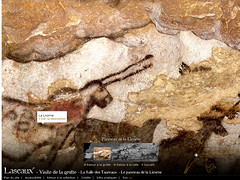 The cave at Lascaux, France, contains nearly 2,000 figures, which can be grouped into three main categories — animals, human figures and abstract signs. Notably, says Wikipedia, the paintings contain no images of the surrounding landscape or the vegetation of the time[6]. Most of the major images have been painted onto the walls using mineral pigments( red and yellow ochre, hematite, manganese oxide and charcoal), although some designs have also been incised into the stone.
The cave at Lascaux, France, contains nearly 2,000 figures, which can be grouped into three main categories — animals, human figures and abstract signs. Notably, says Wikipedia, the paintings contain no images of the surrounding landscape or the vegetation of the time[6]. Most of the major images have been painted onto the walls using mineral pigments( red and yellow ochre, hematite, manganese oxide and charcoal), although some designs have also been incised into the stone.The most famous section of the cave is The Great Hall of the Bulls where bulls, equines and stags are depicted. But it is the four black bulls that are the dominant figures among the 36 animals represented here. One of the bulls is 17 feet (5.2 m) long — the largest animal discovered so far in cave art. Additionally, the bulls appear to be in motion.
A painting referred to as "The Crossed Bison" and found in the chamber called the Nave is often held as an example of the skill of the Paleolithic cave painters. The crossed hind legs show the ability to use perspective in a manner that wasn't seen again until the 15th century.
Many of the bovine figures are aurochs.
The aurochs or urus (Bos primigenius), the ancestor of domestic cattle, was a type of huge wild cattle which inhabited Europe, Asia and North Africa, but is now extinct; it survived in Europe until 1627.
No comments:
Post a Comment